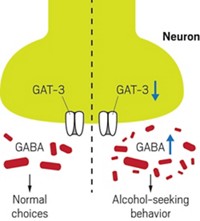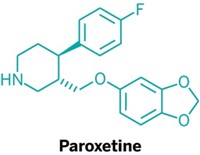Advertisement
Grab your lab coat. Let's get started
Welcome!
Welcome!
Create an account below to get 6 C&EN articles per month, receive newsletters and more - all free.
It seems this is your first time logging in online. Please enter the following information to continue.
As an ACS member you automatically get access to this site. All we need is few more details to create your reading experience.
Not you? Sign in with a different account.
Not you? Sign in with a different account.
ERROR 1
ERROR 1
ERROR 2
ERROR 2
ERROR 2
ERROR 2
ERROR 2
Password and Confirm password must match.
If you have an ACS member number, please enter it here so we can link this account to your membership. (optional)
ERROR 2
ACS values your privacy. By submitting your information, you are gaining access to C&EN and subscribing to our weekly newsletter. We use the information you provide to make your reading experience better, and we will never sell your data to third party members.
Neuroscience
A protein in the brain may link smoking and diabetes
Nicotine overrides the communication pathway between the brain and pancreas, causing high glucose levels in rats
by Megha Satyanarayana
October 16, 2019
| A version of this story appeared in
Volume 97, Issue 41

Smokers develop type 2 diabetes 30–40% more often than nonsmokers, and new research suggests that nicotine’s actions in the brain may be to blame.
Experiments in rats suggest that nicotine may needlessly turn on part of the body’s fight-or-flight mechanism, flooding it with useless glucose that would otherwise get used to run, punch, or kick. Over years of cigarette or vape-pen use, those useless glucose bumps wear out the insulin-signaling pathways in cells and eventually lead to diabetes, says Paul J. Kenny, the neuroscientist at the Icahn School of Medicine at Mount Sinai who led the study (Nature 2019, DOI: 10.1038/s41586-019-1653-x).
Kenny’s team found that the main player in this signaling short circuit is a protein called TCF7L2, which influences two things: the motivation to take nicotine and a conversation between the brain and pancreas.
“It all converges on this one factor,” Kenny says. “Ultimately, a disease like diabetes may be originating in the brain or may reflect dysregulated brain-body interactions, and I think that’s absolutely fascinating and absolutely terrifying.” He wonders if other diseases have brain-body connections that can get similarly disrupted.
His team studies a part of the brain called the habenula, which is involved in our stress response and is chock full of nicotinic acetylcholine receptors, which nicotine binds to and activates, giving people a buzz when they smoke. Kenny’s group had previously reported that mutations that seem to lead to nicotine addiction in humans were often found in nicotinic acetylcholine receptors in the habenula.

The habenula is also full of TCF7L2, which is a transcription factor that acts as an on-off switch for several genes. Rats missing this transcription factor “consume absolutely horrendous amounts of nicotine,” Kenny says.
But TCF7L2 is also expressed elsewhere in the body and is associated with type 2 diabetes. People with certain gene sequences for TCF7L2 tend to get diabetes more often than people with other sequences. Kenny says his team thought TCF7L2 might be doing something in both the brain and pancreas to influence the role of nicotine in diabetes. The researchers found that after nicotine exposure, the nicotinic acetylcholine receptors in rats without TCF7L2 were less sensitive than those of normal rats. Under normal conditions, when nicotine or other molecules turn on the receptors, the proteins eventually enter a sleepy state in which the receptors can’t turn back on for some time. In rats without TCF7L2, the receptors couldn’t bounce back from this state as quickly as ones in rats with TCF7L2. Basically, their brains weren’t responding in quite the same way, Kenny says. And in an experiment that traced the path of neurons, the team found that neurons in the pancreas led to the habenula.
Looking at different genes in the habenula that TCF7L2 is predicted to control, the team found that many were involved in the regulation of glucose metabolism. Given that nicotine is known to cause increases inblood-glucose levels, the team wondered if TCF7L2 might influence this action of nicotine. Lowering levels of TCF7L2 reduced nicotine’s ability to boost blood sugar. And after treating rats for 21 days with nicotine, the team found that the rats missing TCF7L2 had lower blood-sugar levels, suggesting that the transcription factor mediates some diabetes-like symptoms.
Kenny doesn’t think that high blood-glucose levels lead to nicotine addiction. Instead, it’s more likely that all the extra glucose is tamping down the activity of nicotinic acetylcholine receptors, making each puff less effective and leading people to take more puffs. He says one of the next big questions is whether the habenula is playing a role in normal glucose metabolism.
Kenny thinks the link between the stress-response function of the habenula and the nicotine override might lead to diabetes. In an actual fight-or-flight situation, “you’re stressed or you’re frightened, and you need to respond to that,” he says. “You need to access energy reserves, and this stress affects the pancreas.” Over time, this regular stress to the pancreas leads to diabetes. TCF7L2 helps regulate all that.

The team is now looking at drugs that modulate TCF7L2 activity directly or indirectly. One is sitagliptin, sold as Januvia. It’s a diabetes drug that prevents the breakdown of a protein called GLP-1, which is associated with TCF7L2. Mice given the drug tend to consume less nicotine, and Kenny says there are some anecdotal data that people taking Januvia stop smoking (Nat. Neurosci. 2017, DOI: 10.1038/nn.4540). There are several other drugs in this class, and Kenny thinks these drugs might make an excellent one-two punch in people who have diabetes and may want to stop smoking.
Marina Picciotto, a neuroscientist at Yale School of Medicine who was not involved in the research, says these experiments not only define a new way that the brain communicates with the body and vice versa but also help pinpoint how nicotine and smoking affect metabolism by overtaking this conversation.
Rats are a fairly reliable model for nicotine use and overuse, she says, but it remains to be seen if the same things are happening in humans. Kenny’s team is looking at large databases of human genetics, searching for people who might have mutations in TCF7L2 and seeing whether they smoke and if they ever developed diabetes.
There are “all sorts of interactions between [TCF7L2], smoking, and diabetes from human genetics data,” he says. “Nicotine is a major driver of both brain and body diseases. It’s a very problematic drug.”





Join the conversation
Contact the reporter
Submit a Letter to the Editor for publication
Engage with us on Twitter